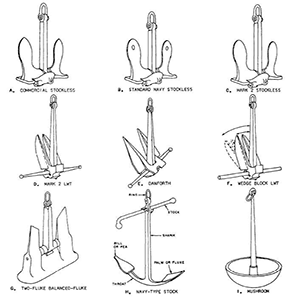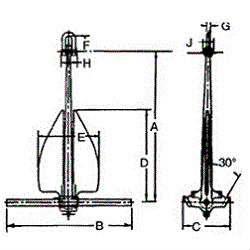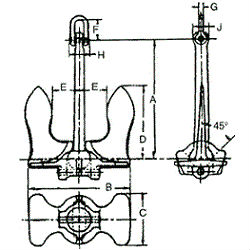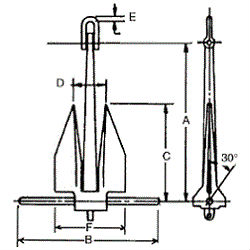Description
Anchor selection is influenced by the specific composition of the ocean floor. Basically, we categorize the ocean bottoms into three groups:
- Mud or silt, which varies the most in consistency and offers little resistance to forces.
- Sand, ideally the most consistent, and where anchors specifically designed reach excellent holding efficiency.
- Rock or Marl, poor holding ground where an anchor’s dead weight is it’s only asset.
The efficiency of an anchor in a given test is expressed in terms of “Holding Power” per pound of its own weight, not in “Proof Test” which indicates physical properties of the material. The “Proof Test” involves applying a static load to the assembled anchor to test its structural design and material properties as related to the holding force.
The fluke angle of an anchor has a definite effect upon the “Holding Power”. The flukes should enter the bottom at an angle that will allow the crown, or head, to penetrate to a depth which can produce maximum efficiency. Any anchor’s performance is dependent first upon its ability to bite into the bottom through the plowing effect of its flukes and secondly upon its ability to maintain a continuous resistance to drag once it is implanted in the bottom. The angle of the fluke to the shaft should approximate 50º in mud bottoms, 30º in sandy bottoms and approximately 43º in various bottoms.
Other considerations in selecting an anchor should include convenience of handling, aptitude for taking hold, physical strength, freedom from fouling (all anchors do-but some in lesser degrees) and the influence developed by the chain’s catenary-which absorbs shock loads and lowers the angle of pull at the anchor by its weight. Anchor holding power is also influenced by duration of drag, bottom conditions and the ratio between the length of the mooring line and water depth as well.
The anchor is the key to effective anchoring or mooring. It is essential to know what to expect from various anchors. The resistance of an anchor to being dragged through a soil has been considered as occurring in two stages: first, biting into the bottom due to the plowing effect of the flukes, and secondly, maintaining a continuous resistance to drag after it is planted into the bottom.
Holding Power is directly proportional to projected fluke area, and shear strength of the bottom material, and inversely proportional to penetration-area resistance. In many cases a smaller anchor with favorable fluke area to weight ratio is more dependable than a heavier anchor.
Holding Power for the two most widely used anchors are as follows:
- Stockless Type anchors, in sand, develop a holding power to weight ratio of seven to one. In mud they develop three to one. The angle of penetration in both cases is 45º.
- Danforth® Type anchors, in sand, develop a holding power to weight ratio of twenty to one, with the angle of penetration being 30º. In mud they develop nine to one with the angle of penetration being 50º.
The depth of penetration in all preceding cases is compiled from three to seven feet in sand, and from seventeen to twenty feet in mud. All calculations incorporate a 0º scope angle.





